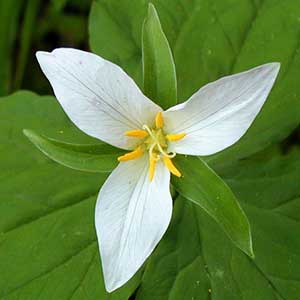Trillium catesbaei
Trillium ovatum
bashful trillium, bashful wakerobin, Catesby's trillium
Pacific trillium, trillium, western trillium, western wake-robin, western white trillium, white or western trillium, white trillium
short, tapered to a point distally.
semierect to horizontal, short, stout, praemorse.
1–2, round in cross section, 2–4.5 dm, slender, glabrous.
1–2, round, 2–5 dm, ± slender, glabrous.
usually raised somewhat, exposing flower;
blade green, often with underlying purplish maroon in well-lighted plants, major veins on adaxial surface deeply engraved, elliptic-ovate, 6.5–15 × 4–8 cm, including elongated, petiolelike base, proximal 1/3 of leaf gradually tapered to base, margins often slightly raised, apex blunt-acute to acuminate.
sessile, subsessile, or short-petiolate;
blade medium green, sometimes blotched and mottled, main veins prominent, ovate-rhombic, 7–12 × 5–20 cm, continuing to expand during anthesis, base rounded, apex acuminate.
opening at or recurved below bracts, rarely erect;
sepals falcate-recurved, green or streaked with purple, linear-lanceolate, 20–45 × 7–8 mm, margins ± flat, apex acuminate;
petals falcate-recurved distally, white, pink, or rose, darkening to pink or nonfading with age, veins visible but not appearing engraved, elliptic-oblong to oblong-lanceolate, 3.5–5 × 1–2+ cm, thin-textured, bases somewhat imbricated, forming funnel-like tube, margins undulate, apex acuminate;
stamens prominent, recurved, 16–25 mm;
filaments white, slightly longer and narrower than anthers;
anthers recurving, bright yellow, 5–14 mm, thick, dehiscence introrse;
ovary inconspicuous, white, angular-ovoid, deeply 6-angled, 4–12 × 3–7 mm, slender, base narrow;
style 2–6 mm;
stigmas prominent, strongly curled (circinate) to erect, connate basally, pale green or white, not lobed, 4–10 mm, uniformly thin;
pedicel deflexed or recurved, rarely erect, angled, 2–4(–5) cm.
erect or nodding, odorless;
sepals spreading to horizontal, green, lanceolate to oblong-lanceolate, 15–50 × 6–20 mm, margins entire, apex acute;
petals erect-ascending, usually wide-spreading from base, exposing entire pistil, white or with pink or blush markings, lacking V-shaped markings, fading to rosy pink, purple, or dark red, veins not deeply engraved, ± linear to widely obovate, 1.5–7 ×1–4 cm, widest at or above middle, thin-textured, margins flat to undulate, apex acuminate;
stamens prominent, slightly recurved-spreading to straight, 10–18 mm;
filaments white, shorter than anthers, slender;
anthers yellow, 4–16 mm, slender, dehiscence latrorse-introrse;
ovary green or white, ovoid, 6-angled, 5–12 mm, attachment ± 3/4 ovary width;
stigmas recurved, barely connate basally, greenish white or white, linear, not lobed adaxially, 6–10 mm, uniformly thin;
pedicel erect to leaning, 2–6 cm.
baccate, greenish or whitish, ovoid-globose, angles less prominent when mature, 1–1.5 cm diam., pulpy but not juicy.
baccate, green or white, ± odorless, broadly ovoid, obscurely winged, 1.2–2.8 × 0.7–1.9 cm, pulpy-moist.
= 10.
Trillium catesbaei
Trillium ovatum
Elliott, author of Trillium catesbaei, apparently recognized one of its forms separately as T. nervosum. This name is still mentioned in British horticultural and botanical literature, but it is rarely found in U.S. literature. North American botanists treat T. nervosum as a synonym of T. catesbaei.
Plants of Trillium catesbaei from deep coves in South Carolina tend to have petals that are deeper pink and longer and wider than those of many other populations.
(Discussion copyrighted by Flora of North America; reprinted with permission.)
Varieties 2 (2 in the flora).
(Discussion copyrighted by Flora of North America; reprinted with permission.)
1. Bracts sessile; petals lanceolate to obovate, 1.5–7 × 1–4 cm | var. ovatum |
1. Bracts distinctly short-petiolate; petals linear to linear-lanceolate, 0.5–2.4 × 0.2–0.6 cm | var. oettingeri |
- Local floras:
BC,
CA,
OR,
WA
- Local Web sites:
CalFlora,
CalPhotos,
Flora NW,
PNW Herbaria,
Turner Photog.
WildflowerSearch
iNaturalist (observations)
USDA Plants Database
- LBJ Wildflower Center
- SEINet
- Plants of the World Online
- Encyclopedia of Life
- Wikipedia
- Google Image Search


